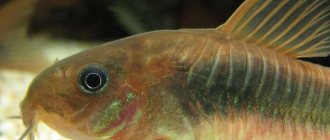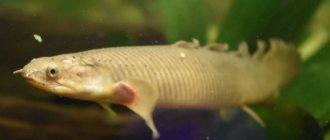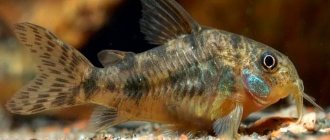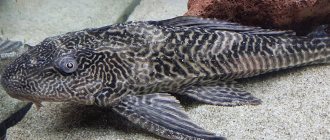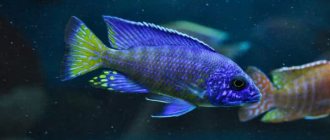Corydoras pygmaeus Knaack, 1966
Or the dwarf catfish, a miniature aquarium fish with an elegant and strict color. An excellent choice for small aquariums, this is one of the few tiny Corydoras species.
Family: Callichthyidae Subfamily: Corydoradinae
Range and Habitat
South America, probably endemic to the Madeira River basin in Brazil.
Inhabits small tributaries, streams and areas of flooded forest. They are often found in large numbers, hiding among coastal vegetation or tree roots.
Prefers to stay in silty areas with little current or in standing waters.
Description
The body shape is slightly elongated, the sides, covered with bone plates, are flattened, the belly line is straight. The ventral and pectoral fins are strongly developed, with a spiny ray on the latter. The caudal fin is two-lobed. There is an adipose fin. There are several pairs of delicate antennae on the jaws.
The general color is silver, with an unbroken black line that extends all the way to the tail and ends in a rounded dark spot. On both sides of the black stripe there are two white stripes. All fins are transparent.
Size:
The maximum length of the species is about 3.2 cm, standard adult sizes are 2 cm for males and 2.5-3 cm for females.
Behavior and Compatibility
In nature, they always live in flocks, so it is advisable to keep at least four in an aquarium; they will behave much more naturally in large groups of 10 or more. In the company of their relatives they feel more confident, become more active and better demonstrate all the peculiarities of behavior inherent only to them.
They often swim in schools in the middle as well as lower levels of the aquarium. They love to lie on the hard leaves of Echinodorus and Anubias.
They are absolutely peaceful, but, given their tiny size, only equally peaceful and small species will suit them as neighbors: rainbowfish, South American tetras, rasboras, dwarf cichlids, shrimp.
Feeding
Catfish are not picky eaters. At home, the following foods are suitable for them:
- live (tubifex, daphnia, brine shrimp);
- dry (flakes, tablets for bottom fish, granules);
- natural (lettuce leaves, dandelion leaves, cucumber slices scalded with boiling water).
It is important to ensure that the food entering the tank is crushed. Otherwise, the individuals will not be able to swallow it and will remain hungry. One feeding per day is enough for the fish to feel great and not overeat.
Aquarium
For a group of catfish you will need a container of 45 liters, with basic dimensions of 45*30*30 cm.
It is very important to choose a soil that should be soft, preferably dark in color. Sand and small pebbles are best as this allows them to dig into the sand without injury. Fish love to swarm in the soil, so there should be no sharp edges in it or in the decorations that could injure them.
It is necessary to have a large number of shelters: grottoes, caves, snags. Several large and smooth stones will be a resting place for catfish. Plants need to be planted around the perimeter of the aquarium so that there is enough free space at the bottom.
Lighting should not be bright, but rather diffused.
Water parameters:
Temperature: 22 - 27° C pH: 6.0-7.5 Hardness: from 2 to 15° dH
Filtration and aeration are required. Changing 1/3-1/4 of the water in the aquarium should be done weekly. Good water quality should be maintained and the soil should be cleaned regularly.
Types of Corydoras
The most popular and interesting corridors are the following: Aeneus (golden). The homeland of this fish is Trinidad and Venezuela. This species can be identified by the golden stripe that runs along the back. The size of the catfish is approximately 6-8 cm. It is unpretentious to living conditions. The only thing that is required is to consistently maintain the water temperature in the range of 23-25 degrees. Speckled Corydoras. Speckled catfish are approximately 7-9 cm in length. This type of fish has a high fin on its back. Female speckled catfish are quite large, almost twice the size of males, with rounded short fins.
This type of fish is quite unpretentious. Speckled catfish can not only withstand temperature fluctuations of 4-35 degrees, but can also live for a long time with a high organic content in the water and without aeration. There is an albino and veiled type, which are a little more capricious, unlike simple ones. Shterba. The body of this five-centimeter catfish is densely covered with a dotted pattern, which turns into parallel stripes on the tail. In adult fish, the fins on the belly are painted bright orange, and the fins on the chest have rays. The surprising thing is that the fish can change color depending on the color of the soil. Panda. The homeland of these fish is Peru, the Ucayali River. The body of catfish is painted white, in some cases with a pinkish tint. The base of the tail, dorsal fin and eyes are decorated with large black spots.
This species does not grow in size larger than 5 cm. Their growth is significantly affected by the absence or presence of live food. The conditions for breeding pandas are quite simple to create: regular aeration, slightly acidified and clean water with a temperature of 23 degrees - that’s all this fish needs. Julii (leopard print). Quite a spectacular fish, which has a yellowish-brown color, similar to the skin of a leopard. It looks most attractive against the background of dark gravel soil. Can grow up to 4-7 cm. Adolfi. The fish is quite small, can grow up to 5 cm. The body is white. There is a bright orange spot in the back of the head. Black stripes can be seen on the eyes and along the back. This type of fish is distinguished by the fact that at home they almost do not reproduce.
CATFISH META (CORYDORAS METAE): CONTENTS BREEDING FEEDING PHOTO
SPARROW CATFISH, Dwarf catfish, Ocellated catfish, Sickle-tailed catfish (CORYDORAS HASTATUS)
GOLDEN CATFISH, VARIABLE CATFISH (CORYDORAS AENEUS)
ADOLF'S CORRIDOR DESCRIPTION, BREEDING, CONTENTS, PHOTO, VIDEO.
Despite the unpretentiousness and undemanding nature of these catfish, there are still some subtleties that you need to know.
The volume of the aquarium is determined depending on the number and size of the fish that will live in it. In the case of corydoras, bottom area is crucial, since these creatures are bottom-dwelling. Experts recommend adhering to the formula: per 20-25 cm of the total length of fish (excluding tails) there should be 0.5 m² of bottom area. As a rule, for a flock of 4-8 individuals, take an aquarium of 50-70 liters.
Water parameters. Corydoras can live in a fairly wide range of conditions, which is good as they can be kept with a variety of fish. For example, they can withstand temperatures from 20 to 29 degrees, hardness from 0 to 18 and acidity from 5.8 to 7.8. However, the following are considered optimal conditions: 20-26°C, 0-12 deg. and 6.4-7.4. The content of nitrates, nitrites and ammonium in water should be minimal.
Bottom arrangement. It is better to put fine sand or gravel on the bottom. It is very important that it does not contain sharp particles that could injure the antennae of the catfish. On a dark background, corydoras look bright and catchy, but a light background makes them faded.
. In several places it is a good idea to make shelters from soft stones and driftwood. Both of them should not release any substances into the water! There should not be a lot of shelters, as they will reduce the bottom area, which means the fish will be cramped.
Plants can be planted quite densely, but be sure to leave free space from which it will be convenient for the corridors to select food. It is better to take plants in the form of spreading bushes, and you can also use moss and ferns. Do not forget that catfish can dig up plants, so they must have strong roots or they will need to be additionally secured in the ground. There should also be free access to the surface of the water. Keep this in mind if you have floating plants in your aquarium.
Sexual Dimorphism
Like most corydoras, it is easily distinguished by gender when viewed from above. Females are noticeably rounder and wider than males, especially when full of eggs.
Females are larger and their belly line is more curved. The fish can also be distinguished by the upper end of the dorsal fin, which is rounded in females and sharp in males.
Reproduction
Sexual maturity occurs in catfish at 8–15 months. With several males and females, pairs are selected randomly, the fish themselves find each other .
Sex differences
Female cockroaches are clearly larger than males and have rounded fins. As spawning approaches, the male's pectoral fin acquires a bright yellow-orange color, and the abdomen becomes blue-violet.
Females have no changes in color, but their abdomen is noticeably rounded.
Spawning
For spawning, the formed pair is sent to a separate tank with a volume of 100 liters .
Before introducing fish, you need to plant plants with wide leaves in it. On their underside the male will build a nest of air bubbles.
Having built the nest, the male begins his courtship, stimulating the female to lay eggs.
Several times the female swims up to the nest, spawns eggs into it, and the male fertilizes the clutch. During the entire spawning period, she can lay up to 500 eggs .
Since the father takes the main care of the future offspring, the mother is removed from the spawning area.
Caring for fry
It takes about a week for the eggs to mature. During this time, they turn into fry, which, after hatching, go to the bottom in search of food. The male is immediately removed from the reservoir.
The babies are fed with crushed live food or dry mixtures for fry, sold in the store.
The fry are kept in the spawning tank until they are two months old . By this time, their body length reaches 5 cm, and the external and sexual characteristics of the species are fully formed.
From this age, juveniles begin to be given the usual food for catfish.
Breeding
If they are kept in a flock of at least 12 individuals without neighbors, then breeding is not difficult and occurs without human intervention. Catfish do not eat eggs and all that is required to raise fry is to feed them on time.
If the school is smaller or there are other fish in the aquarium, then 1-2 females with 3-5 males are placed in a spawning tank with a volume of 10 liters or more. Pair spawning is also possible. It is advisable to keep the spawners separately for some time before spawning, and they can be stimulated by daily water changes of 50-70% to cooler water.
Water parameters in the spawning aquarium: 24-25°C, dGH up to 6, pH 6.5.
The spawning tank should be darkened, leaving one well-lit wall. The female can lay eggs on glass, so it should be placed in a spawning tank, placed near a lighted wall. The productivity of the female is from 30 to 100 eggs.
After spawning, the spawners are deposited or the eggs along with the glass are placed in an incubator. The temperature in the container with caviar needs to be raised a few degrees and methylene blue added so that the water turns light blue. This will prevent fungi from forming on the eggs.
Some hobbyists use certain types of freshwater shrimp to distinguish eggs infected with fungal spores from healthy ones. Cherry shrimp is one of the options. They eat the infected eggs, but leave the healthy ones unharmed.
The larvae hatch on the 3-4th day with a yolk sac, from which they feed for the next 3 days. You can start feeding the fry with ciliates, and then with Artemia nauplii.
At 3 weeks of age, the development of the fry slows down. The color of juvenile fish differs from that of adult fish.

